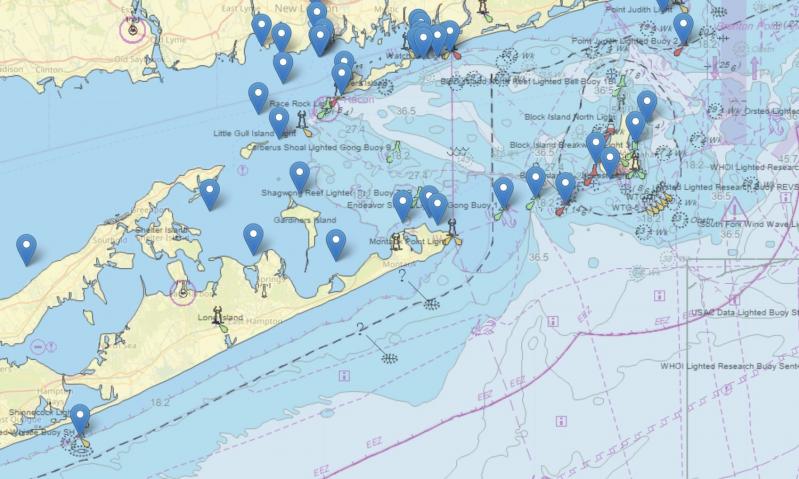Word that the United States Coast Guard has proposed to remove hundreds of navigational markers along the Northeast coast, including buoys, day beacons, and lights, is drawing a mostly negative reaction among mariners in East Hampton Town, with commercial fishermen and others warning that their removal would worsen already dangerous conditions.
The Coast Guard announced this month that it is seeking public comment on the proposal to discontinue 350 buoys in the First Coast Guard District, encompassing the Northeast, as one of several efforts to modernize the approach to physical navigation aids. The design of the current buoy constellation mostly predates the global navigation satellite systems, electronic navigation charts, and electronic charting systems that are widely used by mariners today.
The initiative, according to the Coast Guard, will result in the most sustainable navigation risk reduction to support and complement mariners and the modern era’s larger ships, electronic charting systems availability and requirements, and smartphone navigation subscription apps. A May 2 statement from the Coast Guard notes that “robust physical aids to the navigation network will always complement electronic systems” regardless of technological advances.
The proposed buoy changes are intended to “support the navigational needs of the 21st century, deliver efficient and economical service to manage vessel transit at an acceptable level of risk, better maintain the most critical risk-reducing buoys, and reduce the risk of aids to navigation discrepancies and electronic system failures for those aids most critical to safe navigation,” according to the Coast Guard.
The Coast Guard is soliciting feedback on the proposal before June 13. Mariners have been asked to include the size and type of their vessel, whether it is used commercially or recreationally, how they use the buoys to navigate, and the distance at which they start looking for and using it. Responses are accepted by email only at [email protected].
“The proposal aims to support waterway safety by ensuring the right short-range aids work well with modern navigation technology,” Matthew Stuck, the First Coast Guard District’s chief of waterways management, said in the May 2 statement. “Identifying buoys with the highest navigational significance and those providing less navigational value established the baseline to engage the public for feedback on this proposal.”
But buoys remain essential to mariners’ safety, many commercial and recreational boaters say. Removal of many aids to navigation as proposed by the Coast Guard “will make boating significantly less safe,” Peter Mendelman of Seacoast Enterprises, which operates four marinas in Three Mile Harbor, wrote to the Coast Guard. He asked that only noncritical aids to navigation be considered for removal, adding that none at harbor entrances or dangerous shoals should be discontinued.
A “small but significant population” of boaters do not have GPS navigation on their vessels, Mr. Mendelman added, “and phone-based apps like Navionics are not a reliable alternative” given spotty coverage on eastern Long Island. Furthermore, “phones can lose charge, and are difficult to hold while navigating properly.” Local baymen are not required to carry GPS, he said, and remain reliant on lighted and audible aids to navigation.
“When you are navigating at night or in fog, or just on a rough, windy day, to possibly lose your navigation equipment could be a bad situation,” said Rick Drew, a lifelong boater and angler and a former town trustee. “Also, a lot of navigation devices are not perfect, and sometimes send you on the wrong side of a buoy. Particularly at Tyndall Point off North Haven, the northeast corner of it, and navigation systems have you go over the Tyndall Point sandbar. If you didn’t see that buoy you’d be in big trouble. The Old Silas Rock buoy in the sluiceway — that rock is gigantic and protrudes to the surface of the water. If that green buoy wasn’t there — a lot of people are fishing there now — you could see a boat running aground on that rock very easily.”
Buoys, Mr. Drew said, “also provide a framework for busy entrances like Three Mile Harbor and Montauk Harbor. Those sea buoys alert people to the fact that they’re approaching a busy navigation channel. . . . Avoiding obstructions like rocks, verifying obstacles like sandbars, and providing a safe beacon on the way home at night are all key features of what these afford us. I don’t know the cost to maintain them, but they certainly offer value to the boating community.”
Buoys “certainly help,” Hank Lackner, a Montauk commercial fisherman, said. “It’s a slippery slope, in a sense. The Coast Guard is saying how navigation has advanced so far. Our charting, our plotting definitely has gotten a lot better, but there’s nothing like a buoy to prevent human error, in my opinion. I’d rather see the buoys stay in place.”
Mr. Lackner was among those pointing to the hazard of equipment failure that would be compounded by a loss of physical navigation aids like buoys. Like GPS, “all electronics on a boat are subject to unexpected failure due to blown fuses, corrosion, water leaks, etc.,” Mr. Mendelman wrote to the Coast Guard. “When they fail in the fog, or during rain at night, having lighted and audible [aids to navigation] are essential backups to getting back into port safely.” He has personally experienced this circumstance, he said.
When he teaches boater safety courses, Tim Treadwell, the town’s chief harbormaster, said, “we discuss what the buoys all mean, and I think that it’s important for mariners to have those.”
Another problem with the Coast Guard’s proposal, he said, “is that the buoys they are talking about removing are of the size that it wouldn’t be something that we could privately handle, like we do, say, our [navigation aids] in Three Mile Harbor. So I hope that they don’t do it, and I think that most people in the marine world would agree with me, that it’s nice to have those. If your GPS fails, your cellphone falls in the water, I’d certainly like to have the [navigation aid] there so that I know where I am. And of course, if somebody’s disabled and they don’t have that and they’re near a buoy, it’s really effective for us in a search-and-rescue case. If they say ‘I’m near Green 18,’ we know exactly where to go. I certainly am of the belief that they do more good than anything else.”
David Aripotch, a Montauk commercial fisherman, agreed that buoys are important aids for pleasure boaters, and that losing power offshore would compound the danger presented by the removal of buoys, but “most commercial guys know by eye where you’re supposed to be, or by depth. I think it’s not going to be that much of an issue.” The Coast Guard, he said, “spends a lot on search and rescue, they’re stretched, they’re looking at redundant buoys. They will spend on search and rescue, and I appreciate that.”
“Montauk Harbor is New York State’s largest commercial fishing port, and also a recreational boating hub of the region for residents and visitors,” said Councilman David Lys, the town board’s liaison to the fisheries advisory committee. “Any potential decrease in aid to navigation could potentially be a decrease in mariners’ safety traversing our waters. I would respectfully request the Coast Guard to re-evaluate any potential removal of buoys or aids to navigation.”




